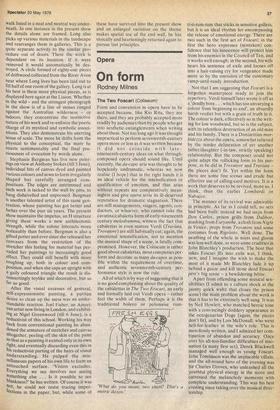Art
Gestural
John McEwen
Most artists have one-man shows every two years or so, so it is asking a lot if you expect their work to evolve very significantly from their previous performance once, that is, they have achieved their own style. It says a lot therefore for Nigel Hall, already firmly and internationally established as one of the best of our younger artists, that his first exhibition with his new gallery, the Annelly Juda (till 3 June), demonstrates an exciting development from his 1976 show at Felicity Samuel. Compared with his work of that time, in which his sculptural course appeared optional and his drawings defensively systematic, some of his latest pieces have a visual clarity that positively purrs with confidence. Means and ends remain, not surprisingly, substantially the same. Aluminium rods of varying degrees of thinness are screwed together and bolted at one point to the wall. As the viewer moves before them through 180 degrees their projection will both contain and suggest a medley of simple and complex volumes; and in much the same way the lines of his charcoal drawings equally fill the empty areas of paper with a mass of suggested volumes. The essence of Hall's work is this movement from the image to the imagination, the phYsical to the metaphysical. By simplifying the image he has strengthened its imaginative properties. The most recent `X' series Of sculptures and a very handsome large drawing upstairs on old and mellow paper, la which a few lines tucked at the corners are all that is required to achieve the implied weight and mass of the blank centre, exemplify this truth. They are his best work to date.
Richard Long, an even more acclaimed artist of the same generation, has several new works on view at the Lisson (till 20 May). As with Hall, implication plays .ah important part. Long makes very specific walks that usually conform to minimal shapes — straight lines, crossed lines or circles — and are undertaken across carefullY selected terrains. They are therefore purposeful to the last degree. He does not carouse or wander or in anyway deviate from his original concept. Sometimes he brings back photographs taken during the walk that embody part of its significance in a different form. Sometimes too he will make a sculpture in the course of it for the saine reason, leaving perhaps an eternal mark on the landscape by rearranging some stones or a less eternal one through the rearrangement of less durable materials, sometimes photographing the result of this as well. The photographs are then mounted and framed, with the minimal details of the
walk listed in a neat and neutral way underneath. In one instance in the present show the details alone are framed. Long also picks up various materials in the landscape and rearranges them in galleries. This is a quite separate activity to the similar procedure out of doors. There the work is dependent on its location. If it were removed it would automatically be destroyed. A circle formed of eighty-one pieces of driftwood collected from the River Avon near where Long lives has been laid out to fill half of one room of the gallery. Long is at his best in these more physical pieces, as is displayed here again at the Lisson. Whether in the wild — and the strongest photograph in the show is of a line of stones ranged against the Australian wilderness — or indoors, they concentrate the instinctive nature of his work and re-enforce the poetic charge of its mystical and symbolic associations. They also demonstrate his unerring sense of scale. The more he drifts from the Physical to the conceptual, the more he courts sentimentality and the final preciousness of evocation by words alone.
Stephanie Bergman has five new paintings on view at Anthony Stokes (till 3 June), individual bits of canvas dyed and painted various colours and sewn to form irregularly shaped but carefully arranged compositions. The edges are untrimmed and each work is tacked to the wall by pins, to hang dishevelled and unpressed. Bergman Is another talented artist of this same generation, whose painting has got better and better over the past six years. The present Show maintains the impetus, an H structure giving these works a new architectonic strength, while the colour interacts more noticeably than before. Bergman is also a gifted potter and ever since she released her canvases from the restriction of the stretcher this feeling for material has pervaded her paintings to increasingly good effect. They could still benefit with more roughing up, both in colour and composition, and when she caps an upright with a gaily coloured triangle the result is disconcertingly toylike and decorative, but so far so good.
After the visual excesses of gestural, self-expressionistic' painting, a puritan desire to clean up the mess was an under standable reaction. Joel Fisher, an Ameri can artist now living in London, and exhibiting at Nigel Greenwood (till 6 June), is a reductivist of this school. Working his way back from conventional painting he abandoned the armature of stretcher and canvas altogether, peeling off the skin of the paint SO that as a painting it existed only in its own right, and eventually discarding even this in his reductivist parting of the hairs of visual understanding. He pulped the miscellaneous papers of his own life to form an untouched surface. 'Vision excludes.
Everything we see involves not seeing something else . . . Is it possible to see blankness?' he has written. Of course it was not, he could not resist tracing imperfections in the paper, but, while some of these have survived into the present show and an enlarged variation on the theme makes spatial use of the end wall, he has stoically and hearteningly returned again to pursue last principles.



































 Previous page
Previous page